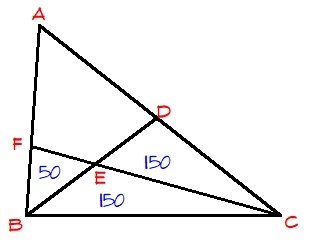Partitioning a triangle

In triangle , and are drawn such that the areas of the smaller triangles are
Find the area of quadrilateral .
Note: The figure is not drawn to scale.
The answer is 250.
This section requires Javascript.
You are seeing this because something didn't load right. We suggest you, (a) try
refreshing the page, (b) enabling javascript if it is disabled on your browser and,
finally, (c)
loading the
non-javascript version of this page
. We're sorry about the hassle.
5 0 + 1 5 0 a + b + 1 5 0 = 5 0 a
2 0 0 a + b + 1 5 0 = 5 0 a
4 a + b + 1 5 0 = a
b = 3 a − 1 5 0 ⟹ 1
D C A D = A B D C A B D A = A E D C A E D A
1 5 0 + 1 5 0 a + b + 5 0 = 1 5 0 b
3 0 0 a + b + 5 0 = 1 5 0 b
2 a + b + 5 0 = b
a + b + 5 0 = 2 b
a − b = − 5 0 ⟹ 2
Substitute 1 in 2 .
a − ( 3 a − 1 5 0 ) = − 5 0
a − 3 a + 1 5 0 = − 5 0
− 2 a = − 2 0 0
a = 1 0 0
It follows that
b = 3 ( 1 0 0 ) − 1 5 0 = 1 5 0
The desired answer is a + b = 1 0 0 + 1 5 0 = 2 5 0 .